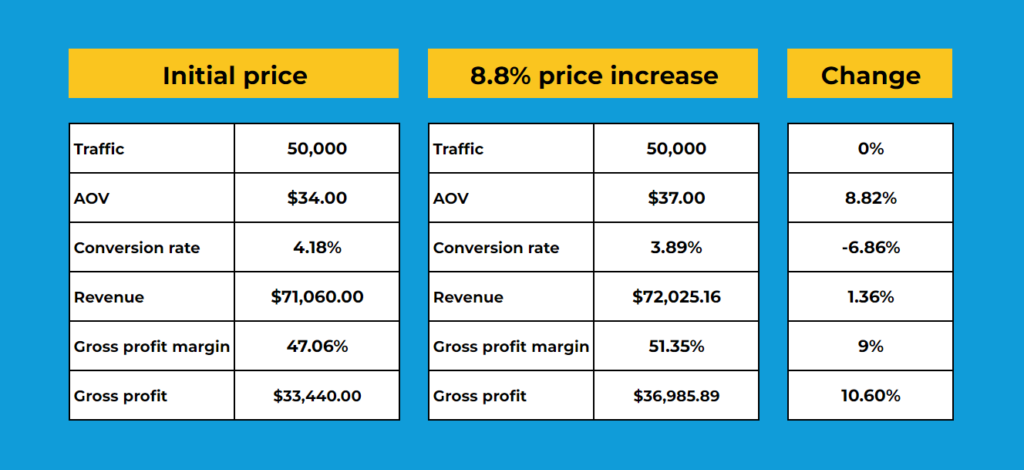If you run an ecommerce business, you already know that scaling it can be rough and sometimes it feels almost impossible. However, there are some things you can do to make it easier for yourself and improve your ecommerce business’ profitability.
You can think of growing an ecommerce business as a combination of two factors: getting more people to your website and the money you get to keep at the end of the day (aka profit). I know it’s an extremely simplistic way of looking at it but bear with me.
I’ve seen bad advice online saying: “Getting more traffic is extremely easy. Set up some campaigns with decent ads and let ‘em rip”. However, you need to keep a balance between the sales and your expenses. If you don’t make any profit, you’re just in the business of shipping boxes.
So, let’s explore some ways to increase your ecommerce business’ profitability so you can spend more on ads without affecting your bottom line.
Revenue-Boosting Strategies
There are multiple ways of increasing your revenue without going for a simple price increase. This might decrease your conversion rates and will negate some of the effectiveness of the revenue increase.
To understand this better, let’s look at an example. Let’s say you increase your prices and the average order value (AOV) goes up from $34 to $37 (8.8% increase). Let’s assume that at the same time, your conversion rate decreases by 7% because you’ve upset some customers.

You can see that the tactic is effective, and it does increase your profit margin, but you can’t implement it indefinitely. You will reach a point of diminishing returns.
So let’s have a look at what else you could do to increase your margins.
Increase Average Order Value (AOV)
Besides increasing prices, there are other ways of convincing your customers to spend more while increasing their perceived value.
You can offer free shipping above a certain order value. 93% of consumers are shopping to qualify for free shipping. And the best part is that the majority of them expect you to offer free shipping.
Implement upselling and cross-selling tactics. Once you have gotten the user’s attention, try to present them with other offers.
With upselling you are showing them the better and slightly more expensive option. And with cross-selling, you are showing them what else they could buy to complete their order. However, don’t overdo it. Show only relevant options as you don’t want to induce decision overload.
Product bundling is another great way of increasing your average order value. You can create a new product entry on your website for a collection or bundle of products. This can also be integrated into your cross-selling tactic.
Another way ecommerce businesses are tackling this issue is through bulk discounts. This way, you can sell a greater quantity of products while shipping just one order.
Optimize your product mix
Checking and categorizing your products based on the profit margin is crucial. You need to know which products are the money-makers and which are complementary.
Selling only high-margin products is a dream, but do not optimize for that. You can run into the risk of decreasing your overall sales.
Instead, look at the conversion paths in your analytics accounts. You may find that some people are looking for a specific product, visit your website, and decide to buy other products. This is what I call an ‘entry product’. And if it happens to be a low-margin product, removing it from your store will only hurt your sales.
Also, pay attention to the product reviews. If you have products with a lot of negative reviews, you might want to stop selling them or replace them with alternatives.
Refine your pricing strategy
Your pricing strategy is key when it comes to keeping a balance between sales volume and profit margins. If the prices are too high, you will have a hard time selling, and if your prices are too low, you will have a hard time staying in business.
It is important to keep an eye on the competition and regularly check how they are pricing their products. Use competitor pricing research tools to be able to quickly react or prepare for their pricing tactics.
Recently, subscriptions have become a way for ecommerce businesses to get predictable revenue. Depending on the type of products that you sell, you might consider creating product packages that you deliver to your customers on a regular basis.
Master customer acquisition
Getting more customers is crucial for any business. So you need to identify the main marketing channels that deliver the best results and see if you can double down on them.
Check whether there is more room to attract customers, but do pay attention at the type of traffic. You don’t want to spend a fortune on previous customers. For example, PMax is notorious for boosting its ROAS by going for warm traffic with retargeting and branded keywords.
The key is to get as much cold traffic as possible and re-engage with it through cheaper channels, such as email.
However, cold/upper funnel traffic can be hard to track properly and you might think that the low ROAS it gets might affect your profits. In that case, you can use something like the marketing efficiency ratio to measure the results.
Cost-Saving Strategies

Boosting your revenue while keeping the costs stable is a very good way of increasing your profit margins. But if you can also work on reducing the costs, you will hit your target much faster.
So, let’s look at some cost-cutting ideas you could use.
Reduce customer acquisition cost (CAC)
Consider this as an extension of the mastering customer acquisition point. Besides looking for the best channels to attract more cold traffic, you can also look at the worst channels.
You need to identify the channels with low/no returns and shift the budget towards other platforms that work or use the budget to test new ones.
To complement your paid channels, you must leverage organic traffic. And I’m not only talking about organic Google traffic. I’m talking about all the channels that are used by your ideal customer profile (ICP) regardless if it’s YouTube, Instagram, Facebook, TikTok, etc. Creating organic content and sharing it will help you in the long run.
This is how you build brand loyalty. If your customers are willing to consume the content you created without paying to show it to them, you’re in a good spot.
In addition, you can make a membership program (paid or free) to encourage repeat purchases. You can run promotions offering perks to your members. Some examples could be free shipping on certain products, temporary discounts, bulk discounts, or just freebies above a certain order amount.
Reduce product returns
Another way of reducing the costs is to look at your returns. Besides the refund, if you offer free returns, you will have to absorb that cost, besides the payment processing fees, labor with checking the items, and restocking.
So aim to explain clearly to the customers what they are buying. Provide clear and detailed product descriptions, offer high-quality product images and videos, and reviews (including the negative ones). Alternatively, you can create a dedicated landing page for some of your products.
Another thing you can do is implement a transparent return policy to manage customer expectations. Include all the details related to the return costs and any restocking fees you might charge.
And don’t offer free shipping for everything. 24% of the consumers are more likely to return the item if shipping is free.
Automate tasks
Automation is a must if you want to preserve your profits, time, and sanity. There are a lot of tools out there that can help you with automating almost everything you can think of.
If you have repetitive tasks (and you most likely do), look around for a tool and check whether it provides enough value to justify its price. If it can be justified, that’s great! You just freed some time that can be spent on more important tasks that would benefit the business.



